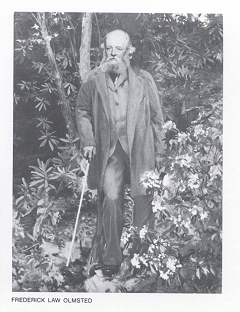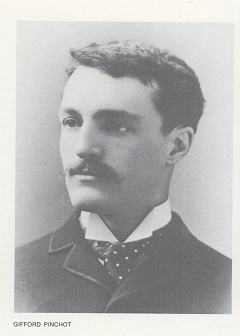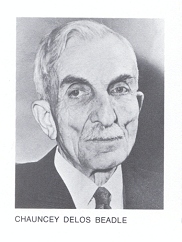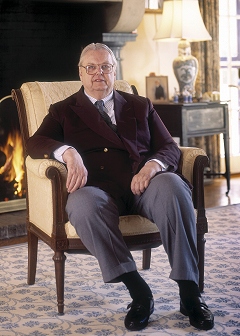

|
The CastAs a turn-of-the-twentieth-century guest at Biltmore House, you arrive by private rail car and travel by carriage toward the estate. After enjoying the three-mile approach road, you reach the French Renaissance chateau along with your companions, personal servants, and considerable luggage. Today the approach road remains impressive, as does Biltmore House and the surrounding countryside. The over one million annual visitors arrive mainly by car or tour bus - and luggage is only necessary if you are booked into the Inn on Biltmore Estate. Now, as a century ago, it helps to know the major players. Though you won't see them in person, the grandeur they created is all around.
George Washington VanderbiltGeorge Washington Vanderbilt was the youngest son of Cornelius Vanderbilt's primary heir. In 1895, he opened Biltmore House to his first guests at Christmastime. The largest private residence in the country, his country home remains filled with the fine antiques, opulent carvings, and notable furniture, as well as his remarkable library. Known as shy and bookish, Vanderbilt was credited with speaking eight languages and accumulating a large library. In his county house, he provided a spectacular setting for the thousands of volumes. At Biltmore House, you see the results of his ability to select the best architect, landscape architect, and craftsmen to create a magnificent setting for himself and his guests.

Technology of the day ensured that his guests enjoyed the latest advances, including an electric elevator, central heating (but no air conditioning), food refrigeration, private bathrooms, an indoor swimming pool, and a bowling alley. Outside they participated in horseback riding, croquet and other games on the gardens, fishing, and walks. He enjoyed reading aloud at the library fireside and was a welcoming host.
Edith Stuyvesant Dresser VanderbiltThe announcement that George Washington Vanderbilt was engaged surprised some. After all, the eligible George was in his thirties and had lived in his mother's home until her death. The identity of his future wife also might have surprised. Edith Stuyvesant Dresser came from a prominent family and was a direct descendent of Peter Stuyvesant. To many, though, she was a relative unknown. Eleven years George's junior, Edith was in her early twenties when they wed in Paris. She became a gracious hostess who focused on both social life at Biltmore House and the betterment of estate workers and nearby residents. Often photographed at Biltmore Village events, other pictures show her in the quintessential over-the-top costumes of the era's society balls.

When George died in 1914, Edith was barely in her 40s. Eleven years later, she married again, this time to Peter Goelet Gerry, US Senator from Rhode Island. Remarriage did not end her connection with the Biltmore estate. After daughter Cornelia left her husband and sons in the early 1930s, Edith became even more involved and remained active in estate management until her death in 1958.
Cornelia Stuyvesant VanderbiltA contemporary of her more socially glittering cousin Consuela (later Duchess of Marlborough), Cornelia was born at Biltmore House as heir and only child of George and Edith. Cosseted from babyhood, she found life more difficult when left fatherless in her early teens. Trouble was, Biltmore upkeep was high and George's plan for estate self-sufficiency had yet to be achieved. Cornelia spent time in North Carolina but lived in other family houses as well. After attending school in Washington, D.C., she wed the Hon. John Francis Amherst Cecil, First Secretary of the British Legation, at age twenty-four. The wedding took place in All Souls' Episcopal Church near the lodge gates of Biltmore House. Two sons were born at Biltmore before she left her husband and sons there. Ten years after her marriage, she divorced and was free to spend her life in Europe.
Richard Morris HuntA long career building other Vanderbilt mansions and even their mausoleum made Hunt, at age 62, the most likely architect for George's country house. Though Vanderbilt started with the notion of a relatively modest size structure, Hunt's inclination toward classic styles sparked his imagination.

On a European trip with Hunt and his wife, Vanderbilt visited stately homes and confirmed what he liked and did not like on a large scale. Back home, work began on the construction of the 250-room house, starting with a three-mile private rail spur to get building supplies in place. Its cost at $77,500 signaled the immense scope of the project. Hunt died early in 1895, the year Biltmore House was complete. His son supervised the completion.
Frederick Law OlmstedCalled the father of landscape architecture, Olmsted came to the Biltmore project in 1888 at age 67. From the beginnings of the project, he worked well with Vanderbilt and Hunt in shaping the land adjoining Biltmore House.

More information about Olmsted and Biltmore House, is here.
Gifford PinchotWhen Frederick Law Olmstead recommended Pinchot to George Vanderbilt, he ensured the progressive management of a major component of the estate's acreage. At the forefront of scientific forestry, Pinchot had studied in Europe where forestry management was more advanced. In 1892, at age 27, he began working for Vanderbilt, earning $2,500 annually. His plan included reforestation, an end to destructive burning, and systematic management measures.

By the end of the next year, his forestry efforts brought a small profit, and his exhibit at the World's Columbian Exhibit created good publicity. By the time he left to become Forester in the US Department of Agriculture in 1898, Biltmore forestry was on a solid footing that was continued by his successor Carl A. Schenck, founder of the Biltmore School of Forestry.
Chauncey Delos BeadleHired in 1890 to assist the head of agriculture, horticulture, forestry, and gardening aspects, Beadle proved to be a long-lasting fixture at Biltmore House. In 1904, Vanderbilt named him superintendent of the estate. Fifty-five years after starting work there, he retired, having helped hold the estate together through both affluent and lean times. In 1940, on his fiftieth anniversary, the Azalea Garden was named for him.

William Amherst Vanderbilt Cecil, Sr.Son of Cornelia and John Cecil, he was born at Biltmore House in 1928. After service in the British Royal Navy and education at Harvard, he worked at Chase Manhattan. But in 1960, he returned to Asheville to revitalize Biltmore House. With revenues falling far short of expenses and major renovations needed, he took charge of the effort to turn things around. Eight years later, he made a profit - $16.34. As he told a New York Times reporter in 1992, "It was a lot more fun than losing a quarter of a million dollars a year."

He went on to many more years of profits, careful renovations, and expansion of the Biltmore name on products from a winery to the Inn at Biltmore. In 1995, he retired, leaving son Bill, Jr. in charge. Though his successor is successful with new endeavors, W.A.V. Cecil, Sr. is the one who achieved George Vanderbilt's goal - the Biltmore estate is self-sufficient at last.
William Amherst Vanderbilt Cecil, Jr.

< to previous article
Questions or comments?
| Forum
| Store
| Publications
| BookLinks
| BookSearch
| BookTopics
| Archives
| Advertise
| AboutUs
| ContactUs
| Search Site
| Site Map
| Google Site Map
Store - Specials
| BookHunt
| BookShelf
| Gold Edition & BookThink's Quarterly Market Report
| DomainsForSale
| BookThinker newsletter - free
Copyright 2003-2011 by BookThink LLC
|

|
|